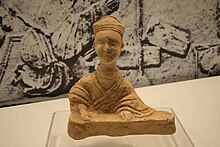Guqin
Guqin ( Chinese 古琴 , Pinyin gǔqín , W.-G. ku-ch'in - "old string instrument", ), in older literature short qin ( Chin.琴Pinyin qín), is a fingerboard zither that played in classical Chinese music . It differs from other Asian zithers in the lack of bridges pushed under the strings as in the Vietnamese tranh or the Chinese guzheng . With her, the sound is picked up with the fingers like a lute instrument , with the frets being replaced by finger marks.
origin
The seven-string guqin has a history of over 3000 years. For no other instrument was the music written down and handed down so early, and so much was written about no other instrument. In the earliest Chinese collection of poems, the Shijing (Book of Songs) (10th to 7th centuries BC), an instrument qin is mentioned several times. Some of the traditional melodies are traditionally associated with well-known people of antiquity such as Confucius , the Daoist philosopher Zhuangzi or the poet Qu Yuan . Confucius himself is said to have played guqin masterfully , a notion popular since the Eastern Han dynasty . However, this cannot be proven historically.
The essay Qincao (琴 操 "Songs for qin ") by Cai Yong (蔡邕, 132–192) is considered the most important early work in Guqin literature . The oldest surviving instruments come from the Tang Dynasty , many of which are still playable.
Style of play
Even if the guqin is occasionally used in ensembles, it is essentially considered a solo instrument. It is the classic instrument used by scholars, painters and poets, philosophers and rulers. The delicacy of her tone finds it difficult to assert itself, much less to make a restless crowd listen. Therefore, the guqin is less aimed at external effects, but is more intended for private meditation and concentration.
The art of guqin music was listed by UNESCO as one of the masterpieces of the oral and intangible heritage of humanity in 2003.
A 900-year-old guqin was auctioned in China in 2010 at a price of 15.4 million euros.
literature
- Manfred Dahmer: Qin - The classical Chinese fingerboard zither and its music in history, stories and poems . Insel, Frankfurt 1985, ISBN 978-3458190240 .
- Martin Gimm : Qin. In: The music in past and present , part 7, Bärenreiter / Metzler 1997, Sp. 1916–1928
- Bo Lawergren: Western Influences on the Early Chinese Qin Zither. (PDF; 1.5 MB) In: Bulletin of the Museum of Far Eastern Antiquities 75, 2003, pp. 79-109
- Cecilia Lindqvist : Qin . Albert Bonniers Publishing, 2006, ISBN 91-0-010580-5 .
- Yoko Mitani: Some melodic features of Chinese qin music. In: DR Widdess, RF Wolpert (Ed.): Music and Tradition. Essays on Asian and other musics presented to Laurence Picken . Cambridge University Press, Cambridge 1981, pp. 123-142
- Dorothee Schaab-Hanke: Attunement to the game on the Qin. Illustrated finger grips from a 15th century Qin manual. Ostasien Verlag, Großheirath 2009, ISBN 978-3-940527-29-5 .
- Bell Yung: Celestial Airs of Antiquity: Music of the Seven-String Zither of China. AR Editions, Madison (Wisconsin) 1997
Audio recordings
- Manfred Dahmer: " Long clarity - China's fretboard zither Qin " (ML-Verlag)
- Cheng Gongliang: " Sounds Of Autumn " (double CD, emma-m)
Web links
Individual evidence
- ↑ Auction: 15.4 million euros for 900-year-old “guqin” . Der Standard, December 6, 2010


